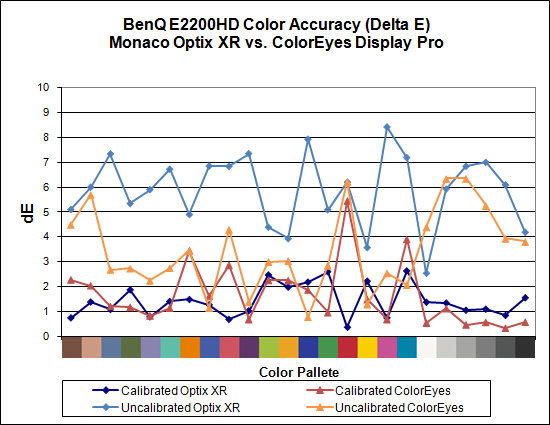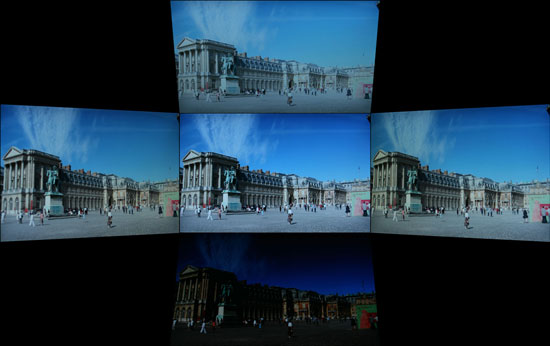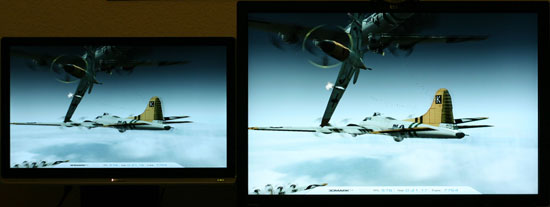BenQ E2200HD and E2400HD - 1080P FullHD LCDs
by Jarred Walton on November 4, 2008 5:00 AM EST- Posted in
- Displays
BenQ E2200HD Evaluation
We'll have results comparing the E2200HD to other LCDs later in the review, but we wanted to give a more detailed look at some of the performance metrics here. The following chart shows the calibrated and uncalibrated color accuracy using Monaco Optix XR Pro and ColorEyes Display Pro with a DTP94 colorimeter. Below that is a 3D color gamut volume compared to the Adobe RGB 1998 standard, which was generated using Gamutvision. Worth noting is that unless you're using a larger color space like Adobe RGB 1998, higher color gamut may not have a noticeable impact. For reference, Windows' default sRGB color space is only about 70% of Adobe RGB 1998. We also have pictures showing viewing angles at 30° and an input lag/pixel response time comparison.


Overall color accuracy is good if not great. Uncalibrated color accuracy is good under ColorEyes Display Pro but not so good under Monaco Optix XR; switch to calibrated color accuracy and the tables are turned, with Optix XR generating a better result -- although the scores are a lot closer than the uncalibrated results. The real benefit is that Optix XR generates a color profile that doesn't have the any colors with a Delta E above 3.0, and only four colors are above 2.0. Compare that with ColorEyes where there are several large spikes, the highest reaching 5.5. The E2200HD doesn't turn in the best Delta E results we have seen, but average dE of around 1.5 after calibration is certainly acceptable.
Color gamut is definitely nowhere near as high as the top displays, and in fact the results are near the bottom of our charts for desktop LCDs. However, the color gamut of 73.5% is more than sufficient for sRGB viewing. Comparing the profile to the sRGB color space, the E2200HD achieves a score of 96%. In other words, unless you're an imaging professional using an expanded color space, the E2200HD will work just fine.
 |
As you would expect with a TN panel, viewing angles are not as good as S-PVA or S-IPS panels. BenQ does offer the 24" FP241VW for those that want something other than a TN panel, although the "base stand" of the FP241VW is completely different from anything else we've reviewed in the computer LCD market. We will be posting a review of the MVA FP241VW and a couple other 24" displays in the near future.
 |
 |
Here you can see a comparison of image lag between the E2200HD and the HP LP3065, an S-IPS panel advertising a 6ms response time. Most of the pictures we took have the same time code at the bottom, but the two samples above show the E2200HD 10ms ahead in one case and 10ms behind in the other. Because of differences in screen refreshes and camera shutter speed, you can get small variations, but on average the E2200HD shows the same "input lag" and similar pixel response times as the HP LP3065. A CRT should still have better pixel response times, but we wouldn't recommend purchasing a CRT anymore so there's little point in that comparison other than to say that the older technology was at least superior in a few areas.
In day-to-day use, the E2200HD is very good. It may not be the absolute best LCD we have ever used, but truthfully we had no complaints at all other than the cheap base stand -- which you can always replace with a VESA compatible mount. The base stand can also get in the way of trying to connect HDMI cables -- we had to put a bit of a kink in our HDMI cable, which isn't something we like to do. One advantage of having a stand that allows you to pivot the display is that you can rotate the display and easily connect any cables. Finally, BenQ really should include a better set of cables -- at the very least a DVI cable in place of the VGA cable, but preferably both, and maybe even an HDMI cable for good measure.
In comparison to the other LCDs we've tested, we would have no problems recommending the E2200HD. Where things get interesting is when you start to compare this LCD to the other 22" LCDs on the market. The E2200HD may not be the best LCD we've seen, but compared to the other 22" LCDs we've looked at it does exceptionally well. It costs a bit more ($250 versus $200 for many competing models), but for the added cost you get a 1080P panel with a matte finish and a three-year manufacturer warranty. There are still other 22" LCDs that provide better color accuracy and color gamut, but if we had to pick one 22" LCD to purchase right now it would be the BenQ E2200HD.










33 Comments
View All Comments
10e - Tuesday, November 4, 2008 - link
Keep in mind, that if you set 1:1 pixel mapping on your video card whether ATI or nVidia, both of these monitors will display 1:1 with black borders. 1680x1050 works perfectly as do other resolutions. To me this is the only reason you need 1:1 pixel mapping, and if the monitor supports it, it's not a big issue if it is not explicitly stated in the menus.A PS3 is a good benchmark here, and if the monitor was set to 1:1 you would get a full screen XMB/dashboard, and most games, running at 720p would display a tiny image with large black borders elsewhere. This is why proper aspect ratio scaling is important.
Additionally, for the seldomly used 480p resolution, the monitor can simply be set to stretch to full screen so that this content is displayed at proper aspect ratio.
I would say 1:1 pixel mapping in all cases is more useful for 16:10 monitors as opposed to 16:9.
wicko - Tuesday, November 4, 2008 - link
One problem I've had with TN panels is that under certain conditions in a game I've noticed a strange artifacting appear. It is most obvious under Source engine games, like Lost Coast, HL2, CS:S, but also noticeable in other games and even in movies. In the game, to reproduce it all you have to do is look at the sky and move the mouse around at varying speeds, and pay attention to the clouds. I noticed this magenta colouring appear in the silhouette of the cloud in the position it used to be, and then it will quickly disappear. Sometimes its other colours, it depends on whats being displayed. I've noticed this in movies (in the latest Bourne movie with the fight where he pistol whips the guy in the end) and in games. I think it was really bad in Quake 4, the part where you're launched into the air in a pod, and fog is rushing past, you can see a strange discolouring going on. Not sure what this is called, I haven't been able to find any info about this. I've noticed it with 3 different monitors with TN panels (a year or two ago) and since I've bought an LG panel with 5ms response time (not sure which panel) I haven't been able to reproduce it. Can anyone tell me what that artifacting is called, and do these new BenQ monitors have the same issue?JarredWalton - Tuesday, November 4, 2008 - link
It may have simply been an issue where the transitions between colors ended up with some image persistence that looked weird. You can see in the lag/response time images that there's an afterimage on moving objects, which ends up being half way between what was there last frame and what will be there in the next frame. It's likely that in some instances the half way point looks magenta.Some people call this "smearing", others "ghosting", or "motion blur". I call it image persistence I guess.
wicko - Tuesday, November 4, 2008 - link
I think this is a little different. I've seen ghosting before, and I was under the impression that low response time monitors don't have that issue. You only see this situation occur with certain colours, otherwise its completely unnoticeable.JonnyDough - Wednesday, November 5, 2008 - link
Whatever you choose to call it, in my experience 5ms or < = none of it. On 8ms monitors it is still noticeable. My advice when buying a monitor is to shoot for integrated no speakers, HDMI, 1080P, matte finish on the screen and bezel, and at a 2ms response time. Also, anything under 21.5" is a waste of time in my opinion. A 19" or 20" monitor will suit many people just fine. I use Samsung Monitors and I think they're fantastic. I have the 204B and the 215tw, both of which have served me well with only one dead pixel in 4 yrs. I got the 20" for gaming with a 2ms response time, and the 22" (8ms response time) because it has component jacks. The only downsides are that I bought them as HDCP and HDMI were just coming into fruition, and that the 215tw has some worthless speakers which not only contribute to a rise in the cost of the product, but the weight and size of it too.wicko - Wednesday, November 5, 2008 - link
Like i said, I've only seen this occur with 2ms panels. 2 of them were samsung (I can't remember what the models were) and another was the Viewsonic Vx922 (although there was considerably less of that happening to the VX922, a much higher end panel than the samsungs). On the LG, a 5ms panel, I haven't noticed this problem, which leads me to believe that its *not* ghosting. I've seen ghosting before. The whole screen kind of slides around, and its more obvious in darker areas. However, this only happens with certain colors, as far as I could tell, and they were all light colours.MadMan007 - Wednesday, November 5, 2008 - link
The ms ratings of monitors is pretty often bs anyway. The overdrive required to get the fast speeds you mentioned can be done well or poorly, it sounds like the ones that had the problem were done poorly.Gizmonty - Tuesday, November 4, 2008 - link
I bought an E2400HD about a month ago (in Australia) and it came with a DVI cable as well as a VGA cable. I've been very happy with it.Slash3 - Tuesday, November 4, 2008 - link
Regarding the lack of 1:1 mapping, it can still come in quite handy for people who sometimes play older games, which commonly supported resolutions no higher than 1280x1024. With 1:1 mapping, this would result in a very close vertical fit, as intended (albeit with the unavoidable black bars on the left and right). Having to stretch the image to what amounts to 28 pixels in each direction (up and down) will result in reduced image quality with no perceived gain in size. This won't affect all users, but it is certainly a feature which separates the quality displays from the budget models.For 1280x720 content, scaling to fit is the obvious solution, as the aspect ratio is unchanged. That said, it's always nice to have the option. Sometimes, the pixels should only go where they're intended to be.
JarredWalton - Tuesday, November 4, 2008 - link
Agreed... which is why I list it, but at the same time it's not quite as critical as getting the AR correct with stretching (at least if the user asks for it). 1:1 is just a nice extra, which is becoming less necessary as time goes by. If it's there, though, bonus points. :)